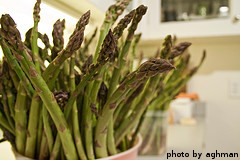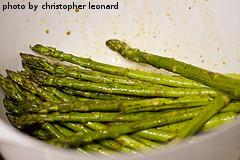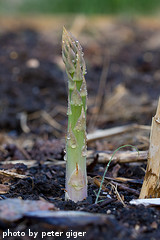How to Grow Asparagus
Interested in how to grow asparagus? You've come to the right place. Growing asparagus is a unique process that requires a lot of patience. However, if you like to eat asparagus, the rewards are definitely worth the wait. And over the long run, asparagus is much less expensive to grow yourself, compared to purchasing it in the grocery story, especially with current food prices, and that goes double if you want organic asparagus. Asparagus is unique because it takes at least a year from the time you plant until you can harvest. As the plant gets older, more and more shoots are available for harvest over a longer period of time.

Asparagus is a perennial vegetable, meaning it will come back year after year on it's own. Once you have an established asparagus patch, relatively little effort is required to maintain the plants. Most asparagus plants have a 10 year life expectancy. However, we have heard of cases where the plants live much longer.
Asparagus plants are either male or female. The male plants are more desirable because they produce many more smaller stalks. The female asparagus plants typically produce much fewer and larger stalks.

Asparagus is a very healthy vegetable that has several good properties. It has a high folic acid content, which has been shown to prevent birth defects. Some studies suggest that adding asparagus to your diet may lower cholesterol levels. Asparagus also contains antioxidants that are known to help prevent cancer. Additionally, some studies suggest that eating asparagus increases the success rate of chemotherapy.
Asparagus can be prepared a variety of ways - fried, steamed, sautéed, roasted, grilled or eaten raw. We like to save the thinner stalks for cooking, and grilled asparagus is one of our favorite dishes every spring. We like to take the thicker stalks and cut them into thin ribbons and put them in a salad or an omelet. We've even made pickles out of asparagus stalks, using quart-sized mason jars.
Asparagus plants are usually grown in a traditional garden. Because they get large after a couple of years, they are generally not grown in containers, although it's not unheard of if you have a large enough container.
Asparagus plants require a loose and airy soil to be grown successfully. They need to be planted relatively deep to establish a successful and expansive root system. Asparagus will tolerate partial shade, however the more sun the plants get, the higher the yields will be.
A mature asparagus plant will produce about 1 pound of spears per year on average. This can fluctuate depending on growing conditions. In general, if your family likes to eat fresh asparagus, plan on growing around 5 plants per person. Grow more plants if you want to can or freeze asparagus.
Asparagus is one of the first edible plants to emerge and be harvested in the spring. In our own garden, it's usually a race between the peas, carrots, radishes and asparagus as to which one will be ready first. Because we try to eat seasonally, we usually spend the winter looking forward to eating tons of asparagus in the spring. And then, as spring turns into summer, we're actually pretty tired of eating asparagus, because we end up eating it a few times a week for several weeks.
As the summer months heat up and well after the harvest is over, it's amazing how large the asparagus plants will get. Each of the tips from each stalk will open up into a large fern, soaking up as much sun as they can possible get.
Asparagus generally grows best in climates with cold, freezing winter weather. This allows established plants to enter a dormant stage, where they can rest and store up energy to come back bigger and better the following spring. Without cold weather, the plants end up as large ferns and they don't produce good spears.
Quick Overview of How to Grow Asparagus
Planting: Crowns are planted in rows, with 18 inches between plants and 5 feet between rows (the plants spread out quite a bit over time).
Fertilizer: Choose one with a higher ratio of phosphate and potassium to nitrogen (A 5-10-10 formula works well). Apply during the early spring and then again in the summer, when the plants are spreading out.
Water: Keep the soil moist, but not wet.
Harvest: Pick the spears when they are 6-9 inches long and still have tight tips. The quality of the stalks will go down as the tips open up.
Recipes: After harvest, asparagus can be fried, steamed, grilled, boiled, pickled, baked, sautéed, roasted or eaten raw.
Click on the following links to learn about planting, fertilizing, harvesting and cooking asparagus.

Click here to move from our How to Grow Asparagus main page to our Planting Asparagus page
Click here for information about watering and fertilizing asparagus
Click here to learn about harvesting asparagus
Click here for information about different varieties of asparagus
Click here for asparagus recipe ideas